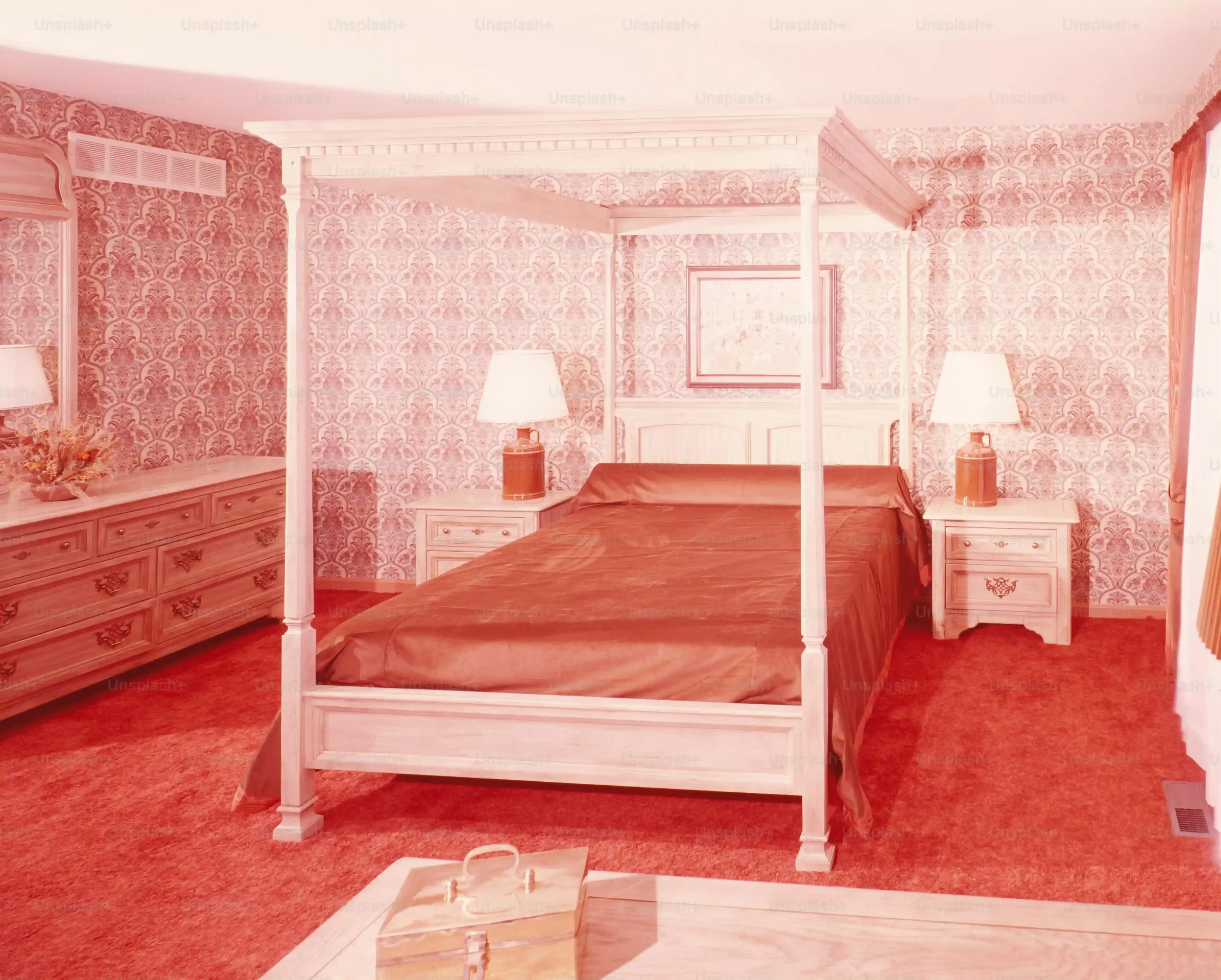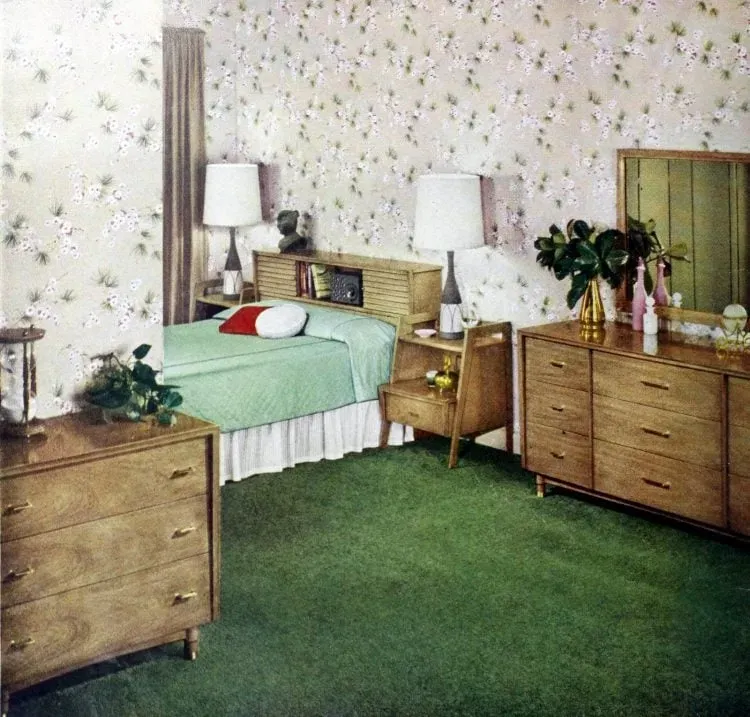Table of Contents
Ever scroll through Pinterest or walk into a cool vintage shop and think, "Yeah, I want my bedroom to feel like that"? There's something undeniably appealing about the furniture from the 1950s. It’s not just old stuff; it’s furniture with a story, often built to last in ways sadly uncommon today. Maybe you picture sleek, low-slung dressers or maybe something a bit more atomic-age quirky. Whatever image pops into your head, chances are it falls under the umbrella of 50s bedroom furniture.
Decoding the Look: Identifying Your 50s Bedroom Furniture
Decoding the Look: Identifying Your 50s Bedroom Furniture
Beyond the Atomic Starburst: What Defines 50s Bedroom Style?
So, you've seen the pictures, maybe even touched a piece, and you're pretty sure it's from the 50s. But how do you know for certain? It's more than just a general "old" feeling. 50s bedroom furniture has a distinct vibe. Think clean lines, often with a slightly organic curve thrown in. Materials matter – you'll see a lot of solid wood, frequently walnut or oak, but also veneers. Legs are usually tapered, sometimes angled outwards in that classic mid-century stance. Hardware is key; look for simple, often brass or brushed nickel pulls, sometimes integrated into the drawer design itself. It wasn't overly ornate like earlier periods, leaning towards function with a dose of style.
Spotting the Details: Common Features of Authentic Pieces
Getting into the specifics helps nail down the era. Drawer construction in authentic 50s bedroom furniture often features dovetail joints, a sign of quality craftsmanship that's less common in cheaper modern pieces. Look at the finish – original finishes can show their age, but they often have a warm, rich patina. Upholstered headboards, when present, were typically simple rectangles or gentle curves, sometimes with simple tufting. Color palettes tended towards earthy tones, pastels, and sometimes bold accent colors like turquoise or red, often seen in laminate tops or painted details. If a piece feels solid, looks understated but stylish, and has those tell-tale tapered legs or specific hardware, you're likely looking at genuine 50s bedroom furniture.
What are some common tell-tale signs of authentic 50s bedroom furniture?
- Tapered or angled legs
- Simple, often brass or brushed metal hardware
- Solid wood or quality veneer construction
- Dovetail drawer joints
- Understated design with minimal ornamentation
- Original finishes with a warm patina
Finding Authentic 50s Bedroom Furniture Sets
Finding Authentic 50s Bedroom Furniture Sets
Hitting the Pavement: Where the Good Stuff Hides
so you know what you're looking for – that cool, tapered-leg dresser or a full 50s bedroom furniture set. Now, where do you actually *find* these things? Forget your average big-box store, obviously. The real treasures are out there, but you have to hunt. Think local antique malls, the kind where each booth is run by a different dealer with varying tastes and prices. Flea markets, especially the larger, well-established ones, are goldmines, though you'll need to dig. Estate sales are fantastic because you're buying directly from a home, often where the furniture has lived for decades. You might find a complete set tucked away in a spare bedroom.
Browsing Online and What to Watch For
Beyond hitting the pavement, the internet offers a vast landscape for Finding Authentic 50s Bedroom Furniture Sets. Sites like Etsy and eBay are obvious starting points, connecting you with sellers worldwide. Specialized vintage furniture sites exist too, often curated by dealers who know their stuff. The upside? Huge selection. The downside? You can't touch or inspect the piece in person before buying. This means you rely heavily on photos and descriptions. Ask for more pictures, especially of joints, hardware, and any wear or damage. Don't be shy about asking questions regarding provenance or condition. A good seller will provide detailed answers. Be wary of overly enthusiastic descriptions without photographic evidence of quality.
Places to scout for authentic 50s bedroom furniture:
- Local Antique Malls and Shops
- Large Flea Markets
- Estate Sales (check local listings)
- Online Marketplaces (eBay, Etsy, specialized vintage sites)
- Auction Houses (sometimes have furniture lots)
Popular Styles and Materials in 50s Bedroom Furniture
Popular Styles and Materials in 50s Bedroom Furniture
Mid-Century Modern's Bedroom Takeover
When people picture 50s bedroom furniture, they're often thinking of Mid-Century Modern. This wasn't just a design phase; it was a whole movement towards function, simplicity, and clean lines. In the bedroom, that translated to dressers and nightstands sitting low to the ground, often on those signature tapered legs. Materials were typically solid wood, with walnut and oak being front-runners for their rich grain and durability. Veneers were also common, allowing for interesting patterns and more accessible price points. Think of designers like Heywood-Wakefield with their blonde finish and rounded corners, or the more angular, architectural pieces that became hallmarks of the era.
Beyond Wood: Laminate, Metal, and Bold Accents
While wood was dominant, 50s bedroom furniture wasn't afraid to mix it up. Laminate tops, particularly in pastel colors or speckled patterns, were hugely popular for dresser and nightstand surfaces. They were practical, easy to clean, and added a pop of color. Metal, especially wrought iron, showed up in headboards and sometimes bed frames, offering a lighter, more delicate look compared to bulky wooden beds. Upholstery, when used on headboards or benches, leaned towards simple textures and solid colors, occasionally featuring geometric patterns. It wasn't just about the big pieces; hardware often featured brass, copper, or brushed nickel, adding subtle metallic gleam.
- Common 50s Bedroom Furniture Materials:
- Walnut and Oak (solid and veneer)
- Mahogany
- Birch and Maple (often lighter finishes)
- Laminate (for tops and accents)
- Wrought Iron
- Brass, Copper, Brushed Nickel (hardware)
Atomic Age Flair and Other Niche Styles
Not all 50s bedroom furniture was strictly Mid-Century Modern. You also saw the beginnings of the "Atomic Age" influence, with designs incorporating Sputnik-like shapes, boomerangs, and more abstract geometric patterns, sometimes seen in drawer pulls or decorative inlays. French Provincial saw a bit of a revival, offering a softer, more ornate contrast to the clean lines, though often interpreted in lighter finishes like white or pastels. Even some streamlined Art Deco influences lingered from previous decades. The point is, the 50s offered a range, from the widely popular minimalist forms to styles with a touch more whimsy or traditional flair, all built with a certain post-war optimism.
Caring for and Restoring Vintage 50s Bedroom Furniture
Caring for and Restoring Vintage 50s Bedroom Furniture
Keeping it Clean: Everyday Care for Your Mid-Century Gems
Look, these pieces have already lasted 70-odd years. The best way to ensure they last another 70 is simple, consistent care. Dust is the enemy, a tiny abrasive that dulls finishes over time. Use a soft cloth, maybe slightly damp, but avoid anything too wet. For cleaning sticky spots or grime, a mild wood cleaner specifically designed for finished furniture works. Test it in an inconspicuous spot first, always. Avoid silicone-based polishes; they build up and can be a pain to remove later. Think of it like skincare for wood – gentle is key. Protecting surfaces from spills and scratches with coasters or mats is just common sense. Don't put a sweating glass directly on that beautiful walnut veneer.
Fixing the Flaws: Tackling Scratches and Minor Damage
Even well-loved 50s bedroom furniture will likely have a few battle scars – a scratch here, a small ding there. Don't panic; most minor issues are fixable without a full refinish. For light scratches, a furniture repair stick or marker in a matching wood tone can make them practically disappear. Deeper scratches might require a bit more effort, perhaps a fine-grit sandpaper followed by a matching stain or finish, but proceed with caution. Swollen veneer? Sometimes a warm iron (with a damp cloth buffer) can help flatten it, but this is a delicate operation. Loose joints often need a little wood glue and clamping. It’s about stabilizing the piece and addressing cosmetic flaws without erasing its history entirely.
Common Vintage Furniture Problems & Quick Fixes:
- Light Scratches: Furniture repair marker/stick
- Minor Dings: Rub a walnut or pecan over the spot
- Water Rings: White rings might lift with mayonnaise or a mixture of baking soda and water (test first!)
- Loose Joints: Wood glue and clamps
- Dull Finish: Gentle cleaning and appropriate furniture wax
When to Call a Pro: Serious Restoration vs. DIY Limits
Sometimes, you find a piece of 50s bedroom furniture that's seen better days – maybe the finish is completely gone, the veneer is lifting everywhere, or there's structural damage you can't figure out. This is when you need to be honest about your DIY skills and tool access. A full refinish is a messy, time-consuming project requiring proper ventilation and technique. Replacing large sections of veneer is an art form. If the piece is valuable, either sentimentally or monetarily, or the damage is extensive, finding a reputable furniture restorer is a smart investment. They have the expertise, tools, and materials to bring it back to its former glory without potentially devaluing it through amateur mistakes. Knowing your limits is part of responsible ownership when it comes to vintage items.
Mixing Modern and 50s Bedroom Furniture for a Cool Vibe
Mixing Modern and 50s Bedroom Furniture for a Cool Vibe
Making it Work: Blending Eras Without Looking Like a Time Warp
so you’ve scored a killer 50s dresser or maybe a couple of sleek nightstands. The thought of going full-on 1950s might feel like you’re decorating a movie set, which isn't everyone's goal. The magic often happens when you startMixing Modern and 50s Bedroom Furniture for a Cool Vibe. It’s less about recreating a specific decade and more about creating a space that feels curated and personal. Think of that clean-lined Mid-Century dresser paired with a modern, minimalist bed frame, or a vintage vanity alongside a contemporary piece of abstract art. The contrast works because the 50s pieces often have a quality and design integrity that holds its own against newer items. It prevents your space from feeling blandly contemporary or drowning in nostalgia. The trick is balance – letting the vintage pieces be stars without forcing everything else to play a period-appropriate supporting role.
Your 50s Bedroom Awaits
So, we've covered the essentials: how to spot the genuine article, where to hunt down those killer pieces of 50s bedroom furniture, and the basic upkeep needed to keep them looking sharp. Integrating vintage isn't about recreating a time capsule; it's about adding character and quality craftsmanship that often feels absent in modern mass-produced items. Finding that perfect dresser or nightstand might take some digging, and yes, some pieces might need a little elbow grease, but the result is a space that feels uniquely yours, built on solid design rather than fleeting trends. Go forth and find your cool.
